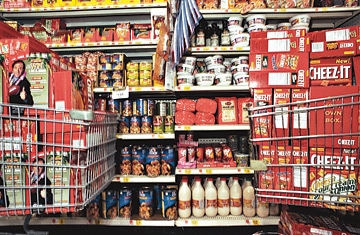
All but the wealthiest readers will have noticed by now that food costs have risen this year. In May grocery prices were 4.4% higher than they were the previous May. If 4.4% doesn’t sound like much–you spend $104.40 now for a cartful that was $100 a year ago–it’s a huge deal to food producers and to budget shoppers, who are making lots of casseroles. The Department of Agriculture anticipates that grocery prices won’t significantly fall before January; if the USDA is right, you would have to go back to 1990 to find a bigger single-year increase. The reasons that food costs more are simple: most of what we eat is shipped great distances, and gas is spectacularly expensive. Also, demand for ethanol has caused the price of corn to spike, and thousands of processed foods contain derivatives like high-fructose corn syrup. Finally, millions of pounds of citrus froze in California this year; oranges cost nearly a third more in May than they did in May 2006. Climbing food prices sound scary, and reporters have filed a spate of alarmist stories about “soaring” grocery bills that are “way up” and causing “sticker shock” . But it actually would be good if food cost a great deal more. A little historical perspective: despite the recent price run-up, Americans still spend less to feed themselves than any other people on the planet–probably less than any monetized society in history. Just 9.9¢ of each dollar we spend is for food, down from 23.4¢ in 1929. By comparison, 16% of household expenditures in Britain go to food; Brazilians spend 23%, Thais 29%. Americans don’t spend much on food largely because we just don’t want to. As a society gets richer, its people tend to use their extra income for things like recreation and education, not daily sustenance. This relationship between food and income–as you get rich, you spend proportionately less to eat–has held so strongly over so many generations that economists have given it a name: Engel’s law . The foodie revolution that began in the ’70s–arugula over iceberg, short ribs over brisket, etc.–has challenged Engel’s law among élites who will pay, say, $80 for a single pound of Nantucket Wild Gourmet cold-smoked salmon. But finding impossibly tender lox is a recreational, not nutritional, pastime. And anyway, most Americans aren’t spending more on food. We simply don’t have to. During the Depression, the government began subsidizing commodities like corn. Today, against all logic, the subsidies continue, and corn-derived snacks and Cokes are so cheap and convenient that, as University of Washington epidemiologist Adam Drewnowski argues, it’s perfectly rational, on a dollar-per-calorie basis, to buy them.